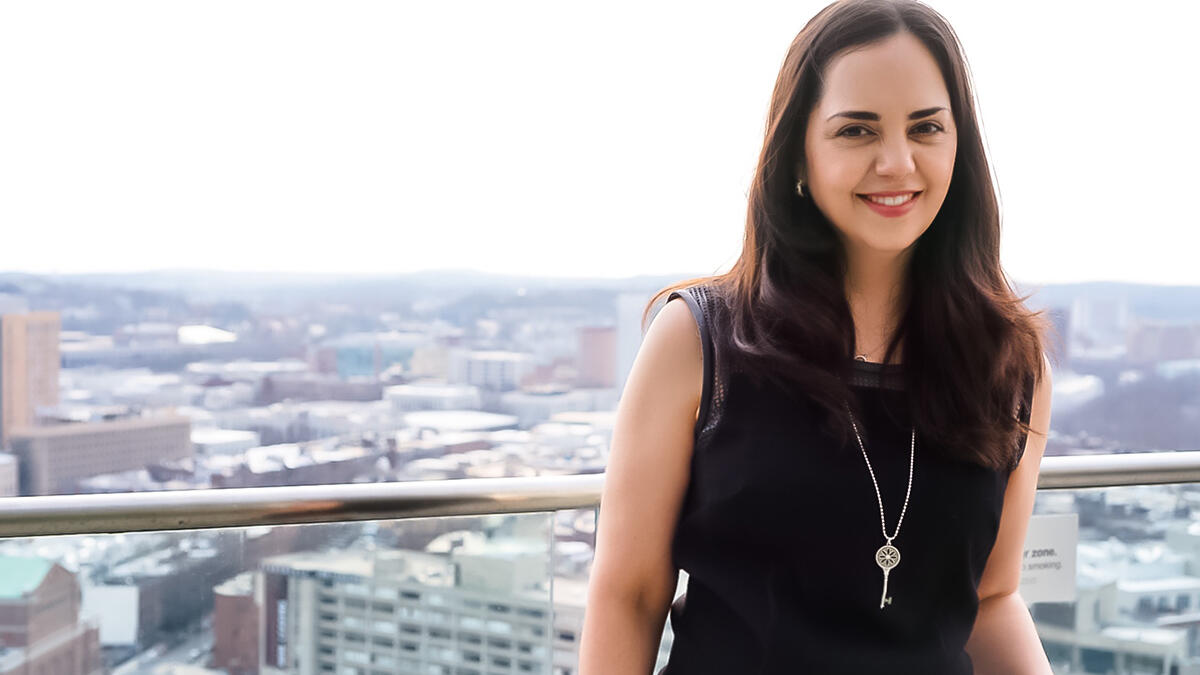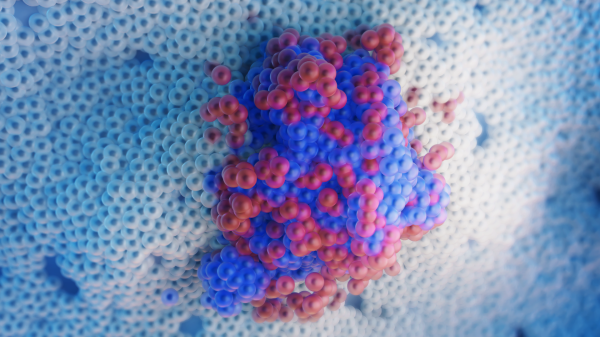ASU alumna designing vaccines at Moderna

Ana Julia Narvaez, director of biological science and translational biology at Moderna. Photo courtesy: @jennybrynnphotography (Instagram)
Ana Julia Narvaez, a 2003 biochemistry PhD graduate from what is now Arizona State University's School of Molecular Sciences, joined Moderna Therapeutics as the director of biological science and translational biology in February 2020.
Narvaez worked as an associate principal scientist from 2015 to 2019 at AstraZeneca in Cambridge, England — one of the world’s most exciting bioscience hot spots — and decided to move to another bioscience hot spot: Cambridge, Massachusetts, where Moderna is located. She made the decision in December 2019 to live centrally in Boston so that she could meet more people, but little did she know that life as she knew it was about to drastically change with the onset of the SARS-CoV-2 pandemic.
A little background
Narvaez was born in Wisconsin, where her parents were studying for their master's degrees. At 5 years of age she moved to Monterrey, Mexico. She received a BS from the Instituto Tecnológico de Monterrey in 1999. After finishing her PhD in biochemistry at ASU in 2003, she continued with postdoctoral research at Stockholm University, Sweden, followed in 2007 by a research associate position at the University of Cambridge, England.
“Ana Julia was an excellent PhD student who not only was able to plan her daily experiments and independently analyze the outcomes, but had the ability to look beyond her immediate activities, examine where her work fit into the broad scientific field, and ask what she could learn in the future,” said James Allen, who was Narvaez’s PhD adviser and is currently a professor in the School of Molecular Sciences.
“I was fortunate to get to know Professor Rivas and other personnel of the chemistry department of the Tec who helped me to encourage their students to join our graduate program,” said School of Molecular Sciences Regents Professor Ana Moore, who made many trips to the famous Instituto Tecnológico de Monterrey to interact with professors and recruit graduate students.
Other successful graduates from the Technológico de Monterrey who completed PhDs at ASU include: Linda de la Garza, currently an associate professor at Valdosta State University, Georgia; Luz Maria Martinez-Calderon and Marcelo Videa-Vargas, who are now both professors at Tecnológico de Monterrey; and Xristo Zarate Kalfópulos, who is a faculty member at the Autonomous University of Nuevo Leon (UANL).
The COVID-19 vaccine and a race against time
Narvaez took time out of her busy schedule to give us some insight into her past year as director of biological science and translational biology at Moderna.
Question: Why did you decide to make the move to Moderna?
Answer: I joined Moderna because I wanted to expand my knowledge to new promising modalities. I had learned a lot from working with small molecule drug discovery, but I felt it was time for a change. I also wanted to continue to grow in an environment that was curious and resilient in its approach and culture. Moderna offered this to me; messenger RNA (mRNA) drugs are coming of age and it is great to be a part of it, and the company also has a culture that fits with my desire to grow and develop and work towards a common goal.
Q: What can you tell us about the development of the COVID-19 vaccine?
A: It has been a unique time from a scientific perspective though the restrictions the pandemic has forced on all of us has made it a little bittersweet. The science is fantastic. Everyone in Moderna has been working very hard towards a common goal; some of the traditional functions are blurred in the company right now. It’s been an all-hands-on-deck and very high energy environment. The number of collaborations is increasing all the time. Everyone is looking for the particular problem at hand and moving on to solve it. It is a very relentless environment trying to tackle this pandemic. Everyone is not only looking at the timelines, but we’re trying to perform as best as possible and deliver as quickly as possible the best science without cutting any corners.
On the other hand we’re all living in a different reality so logistics have changed substantially. Scientists are still going into the lab but we have to establish schedules with the need for physical distancing. We’re constantly having conversations about everyone’s well-being. Our employees are not only scientists but also sons and daughters, mothers and fathers experiencing a constantly changing reality in a state hit hard by COVID. One has to adapt, find a way and remain really flexible and take things day by day.
Q: Tell us about your work at Moderna as well as the challenge of producing and delivering the COVID-19 vaccine to the world.
A: As director of biological science and translational biology at Moderna I live in an organization called Platform. It delivers Moderna technology. We figure out how we have to design the mRNA and what it will look like. We ask ourselves many questions like, how do we deliver these modalities? We are building towards a complete molecular and mechanistic understanding of how our drugs work as well as where to best deliver them. We then have to take these molecular and mechanistic understanding workhorse models and predict what they will look like in a patient. Going through several models and species we pave a road map so we can build sustainability in the next generation of our medicines. We need to understand what the pharmacology will look like as we are learning new things every day about the modality. This helps us with doses and expands our understanding beyond infectious diseases.
To answer the second part of the question the challenge of producing and distributing the vaccine has been huge. A lot of companies including Moderna have made huge leaps in manufacturing without knowing for sure that the vaccine would be used. We kickstarted clinical trials and then turned to the problem of how can we make more doses faster, etc. We had to confirm that companies providing the vials had sufficient supply. We couldn’t afford the luxury of having product then going into the factory. Both had to be done in parallel. Collaborations to scale up manufacturing are still under constant discussion. We need to manufacture as many doses as possible.
Q: Is the Moderna COVID-19 vaccine effective on all currently know variants?
A: Moderna recently published a news release stating that our current vaccine retains neutralizing activity against the new emerging variants. We of course continue to observe how these are evolving.The news release also stated in part that, “Out of an abundance of caution and leveraging the flexibility of our mRNA platform, we are advancing an emerging variant booster candidate against the variant, first identified in the Republic of South Africa, into the clinic to determine if it will be more effective to boost titers against this and potentially future variants.”
Q: Could COVID-19 have been avoided? Will we achieve immunity?
A: It couldn’t have been avoided as pandemics are part of our planet’s evolution. However we can learn a lot and be prepared when the next one arrives. In my opinion it’s “when” not “if.” We’re continually learning from where we got things wrong this time and adjusting. We still need to figure out from the scientific point of view where did the SARS-CoV-2 virus come from? How can we track it? We need to put things in place so that we can discover the next virus sooner. It’s not just a scientific question it’s a societal one. We need to answer questions like is it seasonal? Right now we don’t know enough. We need to adapt and remain flexible so that we can better respond in our future.
Q: Changing the subject, what memories do you have from your time at ASU?
A: In terms of memories at ASU, I have a ton of them! It was a great time in which I learned the foundation on how to do research. While I did not stay in the field that I did my PhD (photosynthesis), I learned a valuable lesson: I learned how to learn. This I took with me as I changed fields throughout my career and helped me expand my knowledge as I aligned it to my passion, which is to deliver drugs to patients in need. On a personal note, I made great friends during this time, with some of whom I still remain in contact and I have fond memories of professors Tom and Ana (Moore) who were incredibly supportive as well as professors Jim Allen and Joanne Williams who mentored me during my PhD.
Q: What advice do you have for current PhD students?
A: My advice to PhD students is be open with your ideas, stay nimble to knowledge and remain curious about science as a whole. Your PhD does not set things in stone, it gives you knowledge beyond your field of expertise that can take you in unexpected directions. Also, do not forget to have fun and enjoy the ride.
Q: How do you assess the status of women in STEM fields today?
A: It’s slowly changing as more women are rising up the executive chain but we still have a long way to go. My personal philosophy is that there is a gap between men and women and we have to continually work to correct that. Not only as a leader when you’re building your team but also across the company. We need to have an ongoing discussion of the way we do things. We’ll get there someday keeping in mind that it’s our duty and responsibility to champion those next in line so that the next generation of female scientists is prepared. We need to make sure that female scientists have the right toolkits and we need to sponsor and mentor them to give them the chance to thrive and push the boundaries as much as they can to make things better.
More Science and technology

Lucy's lasting legacy: Donald Johanson reflects on the discovery of a lifetime
Fifty years ago, in the dusty hills of Hadar, Ethiopia, a young paleoanthropologist, Donald Johanson, discovered what would…

ASU and Deca Technologies selected to lead $100M SHIELD USA project to strengthen U.S. semiconductor packaging capabilities
The National Institute of Standards and Technology — part of the U.S. Department of Commerce — announced today that it plans to…

From food crops to cancer clinics: Lessons in extermination resistance
Just as crop-devouring insects evolve to resist pesticides, cancer cells can increase their lethality by developing resistance to…